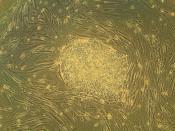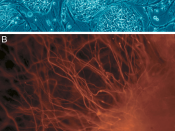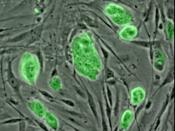In recent medical history stem cells have been used in a variety of medical procedures, including life-saving cancer treatments and the lab-based generation of body parts. With the use of actual human embryos as a source of stem cells, the possibilities for this kind of research are endless. However, the fact that this research results in the termination of the embryo has sparked a nationwide controversy which is split amongst those who are pro-life and those who are pro-choice. Even though the use of human embryonic stem cells in the medical community is a questionable procedure, "the benefits far outweigh the concerns"� (Miller).
As the name might suggest, a stem cell is a type of cell which is the stem of any human beings' life. All stem cells have the capability of self-renewal, that is, they can continually copy themselves. From the time of conception to the sixteenth cell division an embryo is totally composed of totipotent stem cells. These totipotent stem cells have the ability to develop into any cell type of the human body, such as nerve or muscle tissue. After the sixteenth cell division in an embryo, the stem cells are pluripotent. This means that they can form into some, but not all types of cells found in the human body. The type of stem cells harvested from a human embryo and from fetuses aborted in the early stages of pregnancy are called embryonic stem cells.
There are also stem cells found in a human being. These stem cells are responsible for generating new cells and tissue in a person. The stem cells in a person are peripheral stem cells; they can grow healthy cells for the part of the body that they were harvested from. For example, peripheral stem cells taken from a cancer patients'...



Good
good essay but the formating is not up to the standard.
0 out of 0 people found this comment useful.